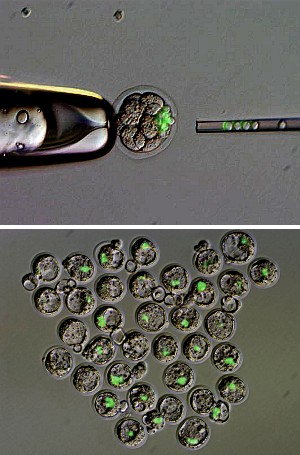
Fig. 1: Functional differences between iPS cells (green) derived from different sources can be tested by injecting them into 8-cell embryos (upper), then culturing them in vitro and implanting them into surrogate mice. iPS cells localize to the inner cell mass of early embryos (lower).
Reproduced from Ref. 1 © 2010 W.-L. Tam
Induced pluripotent stem (iPS) cells—specialized adult cells treated to regain the general properties of stem cells—display different biological qualities depending on the method by which they are generated, a team of molecular biologists led by Bing Lim from the A*STAR Genome Institute of Singapore has found. The work, published recently in Nature, emphasizes the need to test iPS cells functionally, as well as by physical and chemical means.
The minimal requirement for generating iPS cells from mouse embryonic fibroblasts is a combination of Oct-4, Sox-2 and Klf4 (OSK), all master transcription factors that control the process of translating DNA sequences into proteins.
The genes for these transcription factors are typically introduced into target cells using viruses, but the efficiency of generating iPS cells by this method is low. Researchers have tried adding many different compounds to increase efficiency. While the resulting iPS cells seem similar, and activate the same groups of genes, there have been few analyses to determine whether iPS cells generated by different methods differ functionally.
This can be tested in chimeric animals, viable individuals composed of a mixture of cells from two different sources—in this case iPS cells and cells from a set of biological parents (Fig. 1). In a chimera, the ability of iPS cells to contribute to the development of body and germ tissues and to live births can be measured and assessed.
Previous work by other researchers showed that mouse embryonic stem cells in which the protein Nanog is overproduced tend to remain as stem cells and do not differentiate easily. Lim’s research team found the same to be true of cells with reduced levels of the protein Tcf3. Both Nanog and Tcf3 interact directly with the transcription factor Tbx3.
The researchers proposed that Tbx3 might improve reprogramming efficiency and the quality of the resulting iPS cells. They tested their suggestion by comparing the behavior of cells generated using a standard OSK combination with cells where Tbx3 was added (OSKT). The levels of a small subset of critical transcription factors active in embryonic stem cells were matched better in OSKT cells than in OSK cells. And OSKT cells were also generally of higher quality than OSK cells, contributing more to the development of tissues and involved in a greater proportion of live births in chimeras.
“We now want to establish if there are significant differences in ‘quality’ between human iPS clones generated using different factors,” says Lim.
The A*STAR-affiliated authors mentioned in this highlight are from the Genome Institute of Singapore and the Singapore Immunology Network.



